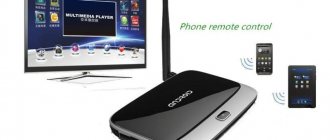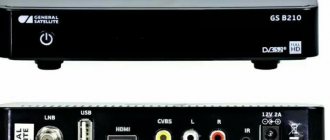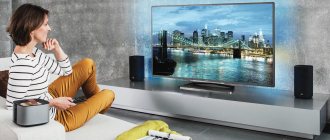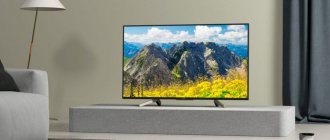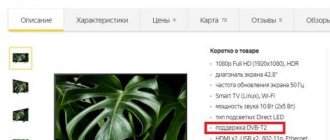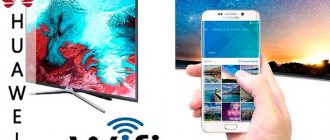Television in our time has ceased to be a novelty and there is no such awe in front of it as in the first half of the last century. Despite this, TV is in almost every home and continues to occupy its central place. We sit in front of it to relax, to learn something, and even just to find a reason to chat with someone. It is difficult to find a modern TV without the SmartTV function. And even though this name used to be quite narrow, now it has literally become a common noun. Such devices not only allow you to watch over-the-air television, but also make it possible to install applications for viewing content, playing games, and even controlling a smart home. And the most advanced models even allow you to control them with your voice. This is exactly what the KIVI TV series 55U7 turned out to be. It may not be the most famous brand yet, but it definitely has something to hook potential users.
There should be a TV in every home. Just for different purposes.
Large screen TV
The model in question is completely called KIVI 55U710KB. From this name it is not difficult to guess that it has a diagonal of 55 inches. However, the brand has other diagonals in its arsenal - from the smallest and, as a result, inexpensive, to huge ones. The maximum screen diagonal for the brand's TVs is 65 inches and that's really a lot. The brand is also represented in all major electronics chain stores, which in itself speaks of its level.
How do old TVs prove the Big Bang theory?
The box immediately makes it clear that one of the key functions of the device is the ability to issue voice commands. People are drawn from different sides, showing that you can talk to the TV , and at the same time demonstrating other capabilities of the included remote control.
Before setting up, you need to go through many of the steps of regular Android.
Is it worth giving up watching TV?
It is worth understanding that television is not evil. It affects people of different generations and even those living in different places differently. For example, rural residents will always find something to do in the yard and are more likely to watch TV in the evening. But at the same time, not being able to see what is happening in large cities, they believe what they are shown. City dwellers, on the contrary, are more skeptical of what is shown to them, but often the basis of their entertainment is television. Children and teenagers absorb information from the screen like sponges, the 25-40 year old generation is more discerning in what they see, but the older generation is “led” to propaganda and advertising.
The main competitor of television is the Internet. Its advantage is that here the user will find all the information he needs and will be able to get different points of view on the problem. On the other hand, the absence of any control imposes its own nuances - porn, cruelty, left-wing beliefs and views.
Thus, the conclusion is simple - there is no need to completely abandon TV, but you should be thoughtful about the content you plan to watch . In addition, it is worth remembering that there is a whole world outside the TV that can offer a lot of interesting things.
Beautiful TV for your home
KIVI 55U710KB looks very stylish, which will allow it to fit into any interior . It has a very thin frame, so the TV takes up little space. When installed on some cabinets or chests of drawers, this can be very important. For those who decide to hang it on the wall, a pleasant surprise will be the small thickness of the case and the fact that the connectors are located parallel to the case. That is, it will not lag behind the wall. I still don’t understand why many manufacturers, even in significantly more expensive models, have not abandoned such connectors.
All main connectors are in place. There is also a side block.
In addition to the usual antenna input, the case has four HDMI connectors (one of them on the side), three USB connectors (one of them on the side), optical output , Ethernet , headphone jack (side) and MiniAV . For me personally, the most important thing was the large amount of HDMI to connect everything in the room - from a computer to a game console. USB can also come in handy if you connect something like a Google Chromecast, another set-top box, or even a small light.
In combination with such legs, narrow frames make the TV really elegant.
Is Smart TV required?
What is smart TV anyway? The word itself means “smart.” A “smart” TV differs from a regular TV in that on it the user can select and watch the broadcast channels or video resources he needs. After all, it has special services and additional programs. Therefore, these devices can be used both as a TV and as a computer. To gain access to all their functions and capabilities, you will need a special cable to connect to the network, or Wi-Fi. Typically, all television receivers come with additional devices. Each company installs its own platform on computers or televisions.
Pros of technology
As soon as the connection and Internet setup is completed, you can fully use the main functions of the smart TV. Does the TV need internet? Each user decides this question for himself. If a person’s occupation often requires him to access the World Wide Web, he will be able to use such a device without any problems.
Internet access from a smart TV is provided as from a regular computer. To do this, you can use the widgets included in the package or the browser. Moreover, there are models that contain installed widgets for Russian social networks. It will also be possible to play audio and video content from external devices. You can use Skype. There are models of television devices with a built-in video camera, but there are not many of them. For most of these TVs, you will need to buy it and connect it yourself.
It happens that there is no time to watch a TV show that interests you. In this case, it can be written to a hard drive or flash drive without any problems. On more expensive models, you can configure this function so that recording takes place even in the absence of the owner. In addition, smart TV functions can be controlled using a tablet or smartphone. There are even models that can be controlled by voice and even gestures. But they are very expensive. And few users will be able to afford to purchase them. However, this is not at all necessary.
Flaws
But like all modern devices and technical capabilities, smart TVs are not without their drawbacks. And when answering the question of whether a smart TV is needed, we should mention them. First of all, Smart TV mainly features entertainment channels and video resources. But if you connect a computer to an ordinary LCD TV, it will perform no less, but even more different functions. At the same time, its cost is much lower.
Video about whether you need to buy a 4k TV
TV with Google Play
In order not to connect anything unnecessary, the TV has the ability to install applications from Google Play - it runs on AndroidTV 9. There are applications of popular services for watching regular television via the Internet, as well as all the main platforms with TV series and movies. Two of the most famous streaming video services are even made available for one-button launch - Netflix and YouTube.
Netflix and YouTube feature prominently on this TV.
The menu of this TV provides a lot of useful information, but it is not overloaded with unnecessary settings. Almost everything is in its place, but it will still take a little getting used to. But the setup is very quick and convenient. Both manual option and activation from a smartphone are available. That's right - it's Android .
Anatomy of a TV: everything you wanted to ask about modern TV technologies
You can't just pick up a TV in 2021. Of course, you can point your finger at the first model from the entrance in a store, or the first one on the list on an online display. You can rely on intuition or the opinion of your significant other. But an informed choice still requires some understanding of modern technologies used in the production of televisions. These are all these incomprehensible letter combinations and scary terms. So if you're at all curious about how OLED differs from QLED or UHD from HDR, you're welcome to this guide. Experienced techies are asked not to grumble about the simplicity of the presentation, but humbly slip this text to their grandmother and thank the authors for saving their nerves when explaining simple truths.
Let's start with simple questions.
What's outside, what connectors and interfaces are there now?
- HDMI is now the most common connector for connecting a TV to signal sources: computer video cards, laptops or multimedia players. Can be used to operate additional technologies, for example: HDCP 2.2 (High-bandwidth Digital Content Protection) - not a connector, but a protocol for protecting digital content transmitted via HDMI, relevant for modern 4K TVs.
- HDMI-CEC (aka Easy Link or Anynet) is a technology that allows you to control multiple devices connected via HDMI cables from one remote control.
Okay, now let's see what's inside. What is TV screen resolution?
This is not an extension, do not confuse the two different concepts. The extension is for the file, the resolution is for the screen. So, screen resolution is the number of pixels vertically and horizontally. The image on a TV screen, like on a computer monitor or smartphone, consists of dots. The more of them that fit on the screen, the clearer the picture looks. But not only the screen itself has resolution, but also the video that is displayed on it. If you watch a low-resolution video on a high-definition screen, the result will be the same as the video itself. Or vice versa, there is no point in watching 4K video on an HD Ready TV.
How is HD Ready different from Full HD and 4K?
The number of points that make up the image. In general, the letter combination HD itself comes from the words High Definition, that is, high resolution. Once upon a time, screen resolution was low, and marketers used this letter combination to distinguish new products with a large number of dots. But the resolution in new devices has continued to increase, and now you can find many variations on the HD theme.
- The term HD Ready (that is, literally “ready for HD”) refers to the most inexpensive TVs that have a resolution of 1280x720, 1366x768, 1400x900 or 1680x1050 pixels.
- FullHD (or 1080p) - screens with a resolution of 1920x1080, this is still perhaps the most popular format, a kind of golden mean.
- UHD or UltraHD are the most modern resolution formats. There are two types: UHD 4K (3840x2160 or 2160p) and UHD 8K (7680x4320, 4320p). Moreover, the second type (read “eight ka”) now, in 2021, is considered new, very expensive and not yet very practical. There are still few TVs of this format on the market, and there are even fewer videos to watch on it. However, recently we could say the same about 4K, and today even mid-price smartphones can shoot it.
What is the difference between 1080p and 1080i?
In sweep type. Look: the number indicates the number of vertical pixels. In the 1920x1080 format there are 1080 of them, and in 1280x720 there are 720 of them. Therefore, the second of these formats is also called 720p. But the letter “p” comes from the word “progressive” and means progressive scanning. This means that all lines, that is, horizontal lines on the screen, are updated when changing frames simultaneously. This seems to sound logical, and in modern TVs this is always the case. But older cathode ray TVs used a different type of scanning: interlaced. With this method, the even and odd rows of points that make up the image are updated in turn. This video format has the letter “i” in its name.
Then what is PPI?
This is completely different, the letters are similar, but the meaning is different. PPI - pixels per inch, number of pixels per inch. This is an important characteristic that shows how densely the TV screen is filled with pixels. After all, in addition to resolution, it has a physical size. A TV with FullHD resolution and a diagonal of 32 inches will have a pixel density of 69 ppi, and the same (FullHD), but 40-inch will have a lower density (55ppi), because the same number of pixels are stretched over a larger screen area.
How much PPI do you need on a TV?
Simply put, the more the merrier. But TVs with high ppi are more expensive and it may not make sense for you to overpay for extra pixels. Here's a simple rule: the further the viewer sits from the TV, the lower the pixel density is sufficient for the visual quality of the picture. From a distance of one meter, an image on a screen with 90 ppi will look approximately the same as just 9 ppi, but from a distance of ten meters. For a distance of two meters, a value of 40 ppi will be sufficient, which approximately corresponds to a 52-inch FullHD TV. But, of course, this is an approximate estimate; it all depends on your wishes for the image and your vision characteristics. To calculate this parameter, there are special ppi calculators on the Internet, for example here. Enter the resolution and diagonal, get the result and don’t bother with formulas.
PPI, DPI, what's the difference?
Don't be confused: DPI is dots per inch. Dots are when printed on a printer, and pixels are on the screen. The DPI parameter has nothing to do with TVs.
Okay, but what should the brightness of the TV be?
Advertising has already taught us: maximum brightness is better. If anything, you can always adjust it in the settings. Brightness is measured in candelas per square meter (cd/m2), sometimes the outdated name “nit” is used, it’s the same thing. Maximum brightness depends on the screen type. If in liquid crystal panels it can fluctuate in the range of 300-600 cd/m2, then for LED screens figures of the order of 1500 cd/m2 and even higher are achievable.
Is it the same with contrast?
Yes, it seems. Moreover, the concept of contrast is related to brightness. A contrast ratio of, for example, 3000:1 (read "three thousand to one") means that on this TV the lightest pixel is 3000 times brighter than the darkest pixel. It is clear that this can be the same pixel, which is three thousand times brighter, displaying white color, than the same one, showing black color. In OLED screens, black pixels do not light up at all, that is, they are completely black, so their contrast can be considered infinitely high.
OLED, LED, QLED - how they differ, you can get confused!
It's easy! Therefore, first you need to understand how TV screens generally work. I'm very fast, don't be afraid. We’re not talking about old tube TVs now, we’ll only talk about modern “flat” TVs. They can be divided into three large groups.
- Liquid crystal display (LCD, liquid crystal display). The principle of operation is this. The light from the backlight passes through a matrix with liquid crystals, and the electronics control this matrix, allowing or not the right amount of light in the right place. This creates an image on the screen. This is the most popular type of screen and there are many varieties. LED TVs. This is the name for LCD TVs that use light-emitting diodes (LEDs) rather than lamps for backlighting. Almost all modern LCD TVs belong to this class, including the different types described below. Once again: almost every TV now is LED (but not to be confused with OLED, we’ll talk about them later). And besides this, he can additionally wear some other letter combination. For example:
- Direct LED is a backlighting method in which LEDs are placed over the entire screen area. Allows flexible control of the backlight in different areas of the screen.
- Edge LED - in such TVs, LED backlighting is placed only on the sides of the screen. This makes it possible to make TVs very thin, but degrades the uniformity of the backlight.
- QLED (Quantum LED) - screens with “quantum dots”, Samsung technology (we wrote about it in detail). LG also has a similar technology, where it is called NanoCell.
- ULED is the name of the Hisense brand technology complex. This is not a separate type of matrix, but a set of software (algorithms) and hardware (image processing processor) solutions to improve picture quality.
Well, have you sorted out the “ice”?
Yes, but there is also IPS, PVA, MVA - what is it?
This is a little different, here we are talking about different types of matrix control and methods of its production in LCD screens.
- TN and TN+Film are old “passive” types of matrices with small viewing angles; they are not used in modern TVs. TFT is an “active” TN matrix, where each pixel is controlled by a separate transistor.
- SFT, IPS, PLS - further development of this technology with improved color reproduction, brightness and viewing angles.
- MVA, PVA - modern technologies based on VA.
In short, the modern choice often comes down to IPS versus MVA, and for most consumers there may not be a radical difference between them.
So, what is HDR?
These are also three letters, but from a completely different area. HDR (High Dynamic Range) is a technology for increasing dynamic range. More precisely, the general name for all technologies of this type. The human eye sees the world around us with many shades and nuances of light and shadow. The TV screen spoils everything; the picture on it is much poorer. Roughly speaking, compared to “regular” displays, displays with HDR show a dark object darker, a light object lighter, and colors as close as possible to how the operator’s eye saw them when shooting video. Or the director's imagination during editing. Equipment manufacturers have taken this problem seriously and have produced many technologies that increase the dynamic range. A detailed description of how HDR works can take more than one separate article, so for simplicity, remember what HDR does for video:
- more gradations of shades (technically this is called “color depth”, which is measured in bits, the more the better);
- more colors in general (they say: “wider color space”);
- higher maximum brightness (we already talked about nits and candelas).
What types of HDR are there?
There are many of them, it’s easy to get confused, although in general they all solve the same problem. But it often happens that one TV can work with several types of HDR content at once, this is convenient. So, here are the letter combinations you can find on TV boxes:
- HDR 10 is the most popular and most widely adopted standard. Provides 10-bit color and supports display of up to 1.07 billion shades.
- HDR10+ is an updated version of HDR10, supported on Samsung and Panasonic TVs, featuring dynamic metadata (that is, additional information inside the video file indicating how to display it correctly).
- Dolby Vision is an HDR technology from Dolby, a renowned company in the field of high-quality sound. They also do great with video: the technology supports not only 10, but also 12-bit color (that’s more than 68 billion shades), maximum brightness of up to 10,000 nits, and dynamic metadata. This technology can be found in TVs from Sharp, Phillips, Hisense, Vizio and other brands.
- HLG and HLG10 have nothing to do with the LG brand; these technologies were developed by BBC and NHK. Video of this standard does not contain metadata and is compatible with a wide range of devices.
- Advanced HDR by Technicolor is the general name for a group of technologies used in Philips TVs. In essence, this is the “author’s interpretation” of the standards described above.
These are the basic HDR technologies, the “pillars” so to speak. Solutions from different TV manufacturers are based on them, often of a purely marketing nature. Here is a non-exhaustive list of examples:
- Samsung: QHDR and Quantum HDR,
- LG: Cinema HDR and HDR Pro,
- Hisense: HDR Supreme,
- Philips: HDR Plus, Perfect and Premium.
So, with such TVs, any video will be in HDR?
No, the video must also be “special”, in the appropriate HDR format. And the TV must be able to display this format correctly so that the result differs from “regular” video.
So where can you watch HDR video?
Many streaming services and online cinemas have learned to show this kind of video: Netflix, Amazon Prime, Megogo, Ivi, Okko. You can also play HDR games on PS4 or Xbox One S on your HDR TV.
Okay, what other technologies are there to improve video and sound on TVs?
There are many of them, and something new is constantly appearing. Here are a few things for you offhand:
- Wide Color Gamut (WCG) is a kind of predecessor to HDR on TVs, a technology for programmatically increasing the color of a picture.
- Local Dimming is a local screen dimming function that makes the black color more saturated in certain areas of the image.
- Depth Enhancer is a technology for automatically adjusting dynamic contrast.
- UHD Upscaling - “smart” stretching (that is, increasing the resolution) of HD video on UHD TVs.
- Dolby Atmos is a multi-channel surround sound technology. Allows you to create the effect of sound coming from different sources around the listener, an important feature for creating an advanced home theater.
- NICAM is also about sound, but just stereo. This encoding technology allows you to get high-quality sound even with a weak air signal level.
Material created with the support of Hisense TVs
Hisense is a company that has been in the market since 1969 and is the number one selling TV in China and South Africa. Hisense today has 12 research centers and 14 production plants located around the world. A rigorous quality process, a commitment to excellent after-sales customer service, are all done solely to ensure that you are confident that the Hisense product is the right choice for your home.
In 2021, Hisense is introducing TVs to the Ukrainian market that run on its own VIDAA SmartTV platform, created to ensure that all modern TV capabilities are simple and understandable for the user (access to any application in 1-3 clicks). VIDAA U4.0 AI features a convenient and user-friendly interface, support for modern technologies, including voice search and intelligence from global and Ukrainian video content providers:
New products for 2021: Hisense 65U8QF and Hisense 43A7500F TVs have a competitive price and offer Ukrainian customers impeccable quality and modern TV technology at an affordable price:
Hisense 65U8QF
65" 4K ULED TV
Hisense's flagship TV with a Quantum Dot ULED display delivering 1000 nits of brightness. Anti-glare screen with a frequency of 120 Hz, local dimming of 180 zones, AI image upscaling in 4K, support for Dolby Vision and Dolby Atmos technologies. The sound is provided by front-facing JBL speakers. All together makes this TV modern and worthy of the attention of the most demanding buyers.
best picture
Hisense 43A7500F
43-inch 4K TV with great value for money
This 43-inch SmartTV supports 4K resolution and uses Hisense's proprietary UHD AI Upscaler technology to convert images to UltraHD quality. Dolby Vision technology is supported, providing extended dynamic range. There is intelligent scene recognition and automatic image adjustment. The TV's speaker system works with DTS Virtual:X, which guarantees best-in-class sound.
bargain
Voice control remote
I have some complaints about the remote control. To make it smaller, it uses AAA batteries. They will work less than regular AA. And for some reason the cover for replacing them is not made sliding or with a “hook”, as is often the case, but with latches. That is, you need to grab something at the bottom and snap off the entire back panel - you can’t do this with your bare hands, you need a knife, a screwdriver or something like that .
The remote control has a button to call the voice assistant and quick access to services.
It also becomes thinner towards the bottom. This is very convenient for moving through the menu, but when you need to use numbers, the remote control tends to jump out. Otherwise, everything about it is fine. The case material is pleasant, the buttons are informative, and their location is correct.
In any case, one of the most interesting functions of the remote will be access to the Google Assistant. And this is not just controlling the TV and searching for content, but also controlling a smart home. Almost all modern gadgets in this category support Google and you can turn on the lights and do other things by giving voice commands through the remote control.
Is it possible to sleep with the TV on?
Everyday Habit
Television quickly became commonplace. People are used to looking at the screen while eating lunch, doing household chores, or just sitting in an armchair and lying on the sofa. Many even became completely dependent on this zombie box. And we are used to planning our affairs in such a way as to have time to watch the programs of interest. Housewives put off cleaning or doing laundry so as not to miss any episode of the next soap opera. The men were rushing home from work to be in time for the start of the broadcast of sports matches. Watching the news was generally considered obligatory. The children's eyes were glued to the screen as if spellbound when cartoons were shown.
In short, television was one of the most important parts of life. It worked constantly in almost all homes; many even got used to falling asleep with it on, without even wondering whether they should turn off the TV. And this despite the fact that it is no secret to anyone how such addiction negatively affects a person.
4K TV with HDR
Naturally, this is a 4K TV. It also has support for HDR 10 . If you're watching high quality content, the picture will have a lot more detail, especially in the dark areas. For example, movie scenes where an actor is in a dark room will not be a “black square” and you will be able to see what is there. In bright colors, this allows you to make the colors more saturated.
Engineers were able to make KIVI bright and colorful.
ACE Pro Engine is responsible for image processing . According to the manufacturer, it can even improve the quality of not very good content and scale the picture to 4K if it did not initially support this format.
The most terrible products from large lips and Apple TV.
The sound also turned out to be quite good and the SRC audio processor adjusts the audio track using 16 parameters at once. If you compare it with some other models, it is really not bad, but it still falls short of the standards. It is better to buy a separate audio system or at least a soundbar. Moreover, it will cost less than the difference in the cost of KIVI 55U7 and a TV with higher quality sound.
Also, this TV can be hung on the wall.
How does TV affect children?
Unfortunately, modern parents do not always find time to take care of their children. And when they are capricious, you need to play with them and entertain them. But you need to cook food and work. Then it's time for the TV nanny. The easiest way is to sit the child in front of him and turn on cartoons.
Do you think that nothing terrible is happening and everyone is happy? Moreover, cartoons are educational? But no. Let's take a look at what can happen to a child when constantly watching “good” programs:
- nervous system disorders (stuttering, aggressiveness, insomnia, headache);
- vision problems due to overstrain of the eye muscles, subsequently – strabismus and myopia;
- telemania, when a person is addicted to TV;
- obesity - since the child is bored while watching, especially when he is alone at home, he begins to consume sandwiches, chips and other unhealthy foods;
- decrease in intellectual level - when watching, the brain does not strain, there is no need to think.
All these problems can also arise in an adult.
Negative influence in the current moment can seriously affect the future: both on the physical and moral state.
I will not tire of repeating that a person, and especially a child, must develop. The ability to sit on the couch in front of the screen will not give you anything. But other talents that are important to develop can bring success.
Why do you need a TV
To summarize, I would like to say that TV is now almost more important for the home than before. Many people’s eyes begin to twitch when they hear this word, and the phrase “I don’t watch TV” pops up by itself. But modern television is not just a series or talk show on the federal channel, but something more. It displays any content from your phone, other media, and even from the Internet. You can also connect a game console or computer to it. For example, sometimes I even work like this when I don’t want to sit at a desk or pick up a laptop. I brought the signal to the big screen via HDMI and it’s beautiful!
Buy TV KIVI 55U710KB
What is modern television?
We figured out what functions the TV performs. What is modern television? Regardless of what TV channels the viewer watches, modern television is:
- propaganda;
- advertising;
- violence;
- sex.
Some will object to this that there are TV channels Kultura, Spas and the like, which avoid these topics.
But it is no secret that they have a small audience, and they are certainly not watched by children and teenagers, whose minds are often subject to the detrimental influence of the phenomena listed above. It also cannot be argued that such content is typical for all shows. Some of them are aimed at other goals - to replace reality for a person (many housewives have their thoughts in their favorite soap programs) or to create a consumer society (shopping on the couch).
How long can you watch TV without harm?
It is noteworthy that Philo Farnsworth, a pioneer of electronic television, forbade his children to watch TV. However, people of the 21st century are unlikely to neglect watching programs. On the one hand, without the media it is impossible to keep abreast of current events; on the other hand, excess information is harmful to the body. Finding the “golden mean” is simple; just understand at what age how much time can be spent in front of the TV.
Adults
The optimal recommended period is 2 hours of continuous viewing, then rest for at least 4 hours. But hardly anyone follows this principle. Adults are used to deciding for themselves when, how much and what to watch.
Teenager
For boys and girls, the time is limited to one and a half hours. It should also be taken into account that young people use various electronic gadgets in everyday life: tablets, laptops, smartphones, etc. And this means increased strain on the eyes and an unstable child’s psyche.
Child
It is better for children under 3 years old to completely prohibit watching cartoons. But many parents are surprised: “How can this be, if many different educational programs have been created for kids.” If you really can’t wait to develop your child, you need to limit your viewing time to 15 minutes. For preschoolers and primary schoolchildren, access to the screen can be increased to 30 minutes. Sometimes you can cut some slack and allow you to watch a fairy tale or cartoon to the end (1-1.5 hours).
Important! It is easier to negotiate with a child than with an adult. Children willingly replace TV with other interesting activities: walks, family games, etc. Any activity so as not to be bored alone.
Additional options and features
Let's talk a little about things that will make the use of the TV more diverse, but which you can do without.
Camcorder
TVs with SMART-TV are often equipped with a video camera. With its help, you can communicate with friends using applications and social networks, record videos without a computer or smartphone, use gesture control and augmented reality (depending on the capabilities of a particular TV).
Voice control
Another common component of SMART-TV. Allows you to control your TV, search for content, launch programs, etc. using voice commands.
Curved screen
As additional features, some manufacturers offer TVs with a slightly concave screen. It is believed that this creates the effect of presence, the picture is better perceived by peripheral vision. There is no experimental confirmation of this.
Response time
This is the amount of time it takes for one pixel to change its displayed color tone. As a rule, for most models it varies between 1-8 ms. This parameter is most often paid attention to by console lovers who use the TV as a monitor for games, as well as viewers of dynamic films and sports competitions, where the picture changes very quickly. Insufficient response time leads to a blurring effect. However, all modern TVs in a class higher than budget ones do not have this drawback, and manufacturers often do not indicate this parameter at all in the characteristics.
Viewing angle
You've probably noticed that if you look at the LCD monitor from the side, the image darkens and the color changes. OLED and QLED TVs, where the viewing angle reaches 178°, do not know this drawback. In our opinion, this is an insignificant parameter, because people usually don’t watch TV from the side.
Digital DVB-T2
DVB (digital video broadcasting) is a set of digital television standards that were developed by the international consortium DVB Project.
There are three types of standards:
- DVB-T; terrestrial television standard.
- DVB-C; cable television standard.
- DVB-S; satellite television standard.
In order for a TV to receive, “understand” and play video and audio transmitted in accordance with one of these broadcast standards, it needs an installed decoder (tuner) that complies with the standard.
DVB-T, or more precisely, its improved modification - DVB-T2, is built into their TV models by many manufacturers. They do this based on high demand among customers. After all, having purchased it, you do not need to pay for cable or satellite television once a month or year. All you need to do is connect and enjoy free TV, without additional equipment. The DVB-T2 tuner receives a digital signal via a conventional antenna and decodes it into HD quality video.
Installation benefits:
- A large number of broadcast channels (from 20 to 100, depending on the broadcast zone);
- A digital signal is more resistant to distortion than an analog signal;
- High image and sound quality (HD quality).
Smart TV
This feature turns an ordinary TV into a multifunctional gadget. Using a high-speed connection, it connects to various Internet services as well as other home devices. Essentially, Smart-TV gives the TV the functions of a computer. This is achieved using several operating systems: Android TV (in Philips and Sony) - built on the same principles as in smartphones. Supports many applications, the interface will not cause inconvenience to users. Different TVs may have different versions of this OS installed. Tizen is a Samsung development and is installed on this company’s TVs. All Samsung TVs have the same Tizen version. Many Russian-language applications are supported. Also intuitive for users. WebOS - installed on LG TVs. The functionality is very similar to Tizen. Any of these operating systems is optimized for working with a TV. The only inconvenience for some users may arise from the unusual interface.
Plasma panels
According to the analytical company Futuresource Consulting, plasma panels are the second most popular type of TV among buyers. Screen sizes vary from 40 to 80 inches.
Models with smaller screen sizes are difficult to find on sale or they are too expensive for their characteristics. They weigh no more than 6 kg, even the largest options. Wide viewing angle – 180 degrees, service life up to 15 to 17 years. High energy consumption – 70-160 W/h. The cost depends on the size.
Advantages of plasma panels:
- High image quality, especially color rendition, dynamic and dark video scenes;
- Large sizes are favorable in terms of price-quality ratio;
- Long service life;
- Fast response time.
Disadvantages of plasma panels:
- Without anti-reflective coating;
- High energy consumption, uneconomical.
- Heats up to 40 degrees or more
Since 2013, a number of companies have stopped producing plasma panels due to their lack of competitiveness with their liquid crystal counterparts.
The lack of competitiveness, according to manufacturers, is caused by the fact that people do not buy them, preferring LCD devices, since plasma panels do not support high resolutions (above FullHD), they heat up and waste a lot of energy.
How it works Plasma panels are so called because of their design and the method of image formation.
The image is formed by a panel of glass capsules containing a mixture of inert gases (neon and xenon). The back wall of the capsule contains a colored layer of phosphor (red, green or blue). There are three capsules for each pixel. Using electrodes, an electric discharge is supplied to the cell (capsule), which, acting on the gas mixture, ionizes it. Ionized gas (plasma) emits X-rays, which affect the corresponding phosphor layer, causing it to glow. When the luminosity of three cells is combined, a pixel is obtained.
Since voltage is supplied to the electrodes from the switch one by one, and not to all at once, the screen in plasma panels flickers, just like on a CRT. This problem is solved in the same way - by increasing the scanning frequency (frame display).
On modern devices the frequency reaches 400 Hz. The phosphor degrades over time, which affects the image quality, so the service life of this equipment is lower than that of liquid crystal analogues.
